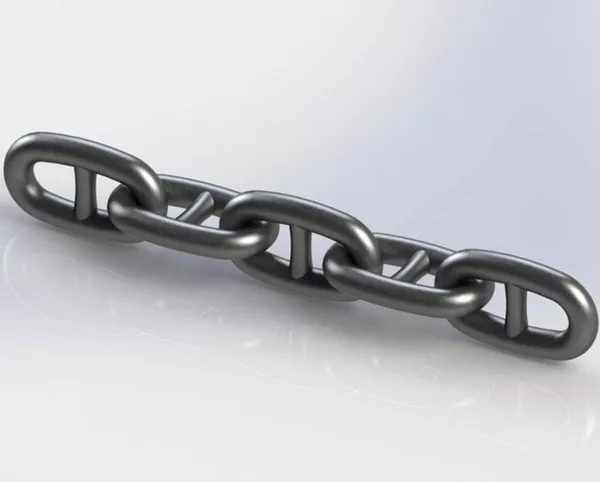While the anchor is the most visible symbol of maritime safety, its true power lies beneath the surface in the chain that connects it to the ship. The ship anchor chain plays a fundamental role in maintaining vessel stability, absorbing shock loads, and ensuring the anchor holds fast in unpredictable sea conditions. Without a dependable chain, even the most advanced anchor cannot perform effectively.
As global trade intensifies and vessels grow larger, the demand for high-quality stud link anchor chain systems has never been greater. These components must withstand enormous forces while enduring harsh marine environments. This article explores the construction, design, maintenance, and sourcing of marine anchor chains, highlighting their essential contribution to maritime safety and performance.
Understanding the Function of Anchor Chains
Anchor chains are designed to connect the vessel to its anchor, distributing tension and maintaining the proper angle between the anchor and the seabed. The weight of the chain provides a catenary effect, which allows for gradual load transfer and prevents the anchor from being pulled vertically.
The length and weight of the chain are critical to the vessel’s ability to hold position. Too light or too short a chain, and the anchor may drag under high wind or current loads. Too heavy or long, and it may reduce maneuverability or add unnecessary weight. Selecting the correct specification of ship anchor chain is, therefore, both a science and an art.
The Anatomy of a Stud Link Anchor Chain
Most modern ships use stud link anchor chains, which are composed of interlocking steel links, each reinforced by a central stud that prevents deformation under heavy loads. The stud increases the chain’s strength, minimizes kinking, and ensures that the chain runs smoothly through the windlass and chain locker.
Each link is precision-forged, welded, and heat-treated to meet international standards such as ISO 1704, IACS, and classification society requirements. Chains are typically supplied in standard lengths known as “shots” or “shackles,” each measuring approximately 27.5 meters. These can be connected using kenter shackles or joining links, allowing flexible length adjustments.
Grades and Materials: Built for Endurance
Anchor chains are manufactured in different grades depending on tensile strength and application. The most common are:
- Grade 2: Standard strength, used for smaller vessels or light-duty applications.
- Grade 3: High-strength, designed for medium to large commercial ships.
- ORQ and R4 Grades: Extra high strength, used for offshore platforms, heavy cargo vessels, and deep-water anchoring systems.
Chains are generally made from heat-treated alloy steel, designed to resist corrosion, fatigue, and abrasion. Galvanized coatings or specialized paint systems may be applied for added protection, especially in harsh saline environments.
Testing, Certification, and Compliance
Given the critical safety role of ship anchor chains, each product undergoes rigorous testing and inspection. Common tests include proof load testing, breaking load testing, magnetic particle inspection, and ultrasonic examinations to detect internal flaws.
Suppliers provide certificates from recognized classification societies such as ABS, DNV, BV, or Lloyd’s Register. These documents confirm that the stud link anchor chain meets international safety and performance standards. Maintaining proper certification is vital not only for vessel safety but also for compliance with insurance and regulatory requirements.
Maintenance: Extending the Life of an Anchor Chain
Even the highest-quality chain requires regular maintenance. Continuous exposure to saltwater accelerates corrosion, especially where protective coatings are damaged.
Effective maintenance includes:
- Frequent inspections: Check for wear, elongation, corrosion, and deformation.
- Lubrication and cleaning: Prevents rust buildup and reduces friction.
- Re-galvanization: Restores corrosion protection after long service.
- Chain rotation: Alternating sections reduces localized wear near the windlass.
Proactive upkeep extends the chain’s lifespan and ensures dependable performance when it matters most.
Factors to Consider When Selecting a Chain
Choosing the right ship anchor chain involves evaluating multiple variables:
- Vessel type and size: Determines chain diameter, weight, and grade.
- Operating environment: Coastal vessels require lighter, more flexible chains; deep-sea vessels need heavy-duty options.
- Seabed composition: Rocky or sandy bottoms influence chain and anchor selection.
- Storage and handling: Chain locker capacity and windlass strength must align with chain dimensions.
- Certification requirements: Classification societies dictate minimum standards based on vessel class.
A trusted supplier helps evaluate these parameters to ensure an optimal balance of safety, performance, and cost.
The Role of Stud Link Design in Safety
The addition of a stud in each link significantly improves chain performance by distributing stress more evenly and maintaining uniform shape under tension. It prevents link deformation and knotting, ensuring that the chain lays correctly both on deck and in the locker.
Stud link anchor chains are also less likely to twist or jam, providing smoother operations during anchoring and retrieval. This design innovation has made stud links the standard for commercial and naval vessels worldwide.
Modern Manufacturing and Quality Assurance
Leading manufacturers employ advanced processes like automated welding, robotic heat treatment, and computer-aided testing to ensure precision and repeatability. Each production batch is traceable, with mill certificates, serial numbers, and chemical composition records.
Quality assurance doesn’t stop at production; reputable suppliers perform independent third-party testing before shipment. The result is a stud link anchor chain that offers consistent performance, longevity, and full compliance with class requirements.
Digital Tools and Lifecycle Management
Today’s ship operators benefit from digital maintenance systems that track chain usage, maintenance intervals, and inspection history. By integrating supplier data into these systems, fleet managers can anticipate wear patterns, plan replacements, and avoid unexpected failures.
Some suppliers even provide RFID tagging for real-time asset tracking, enabling precise lifecycle management and improving overall fleet efficiency.
The Importance of Reliable Supply and Timely Delivery
Maritime operations depend on precision timing. Delays in the delivery of an essential ship anchor chain can halt maintenance schedules or leave a vessel unfit for sailing. Reputable suppliers maintain stock of standard chain sizes and grades, ensuring that critical parts are available when needed.
UAE-based suppliers, strategically located near major shipping routes, have an advantage in serving regional and international customers with quick turnaround and competitive pricing.
Conclusion
In the vast world of maritime logistics, the humble anchor chain remains one of the most crucial components of a vessel’s safety system. From material selection to design innovation, every detail of a stud link anchor chain contributes to the ship’s stability and reliability.
Choosing the right chain, backed by proper certification, maintenance, and supply assurance, safeguards not only the vessel but also its crew and cargo. When the sea turns unpredictable, it is the unseen chain beneath the waves that quietly does its job holding everything together.
Wismar Heavy Equipment Trading L.L.C. stands as a trusted supplier of marine anchor chains and related equipment across the Gulf region. With extensive industry knowledge and a commitment to quality, the company provides certified ship anchor chain and stud link anchor chain solutions that meet international standards. Its robust inventory and strategic logistics network ensure prompt delivery and complete documentation support.



